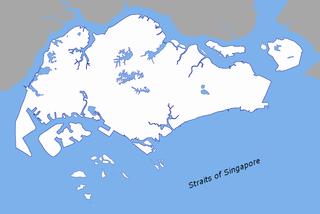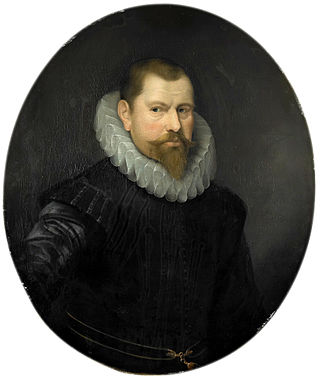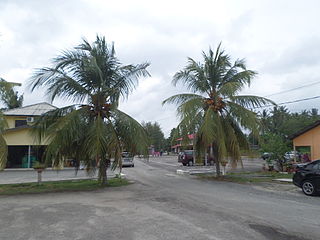
Malaysia is located on a strategic sea lane that exposes it to global trade and various cultures. The name "Malaysia" is a modern concept, created in the second half of the 20th century. However, contemporary Malaysia regards the entire history of Malaya and Borneo, spanning thousands of years back to prehistoric times, as its own history.

The Straits Settlements were a group of British territories located in Southeast Asia. Originally established in 1826 as part of the territories controlled by the British East India Company, the Straits Settlements came under British Raj control in 1858 and then under direct British control as a Crown colony on 1 April 1867. In 1946, following the end of the Second World War and the Japanese occupation, the colony was dissolved as part of Britain's reorganisation of its Southeast Asian dependencies in the area.

The Strait of Malacca is a narrow stretch of water, 500 mi long and from 40 to 155 mi wide, between the Malay Peninsula to the northeast and the Indonesian island of Sumatra to the southwest, connecting the Andaman Sea and the South China Sea. As the main shipping channel between the Indian and Pacific oceans, it is one of the most important shipping lanes in the world. It is named after the Malacca Sultanate that ruled over the strait between 1400 and 1511, the center of administration of which was located in the modern-day state of Malacca, Malaysia.

The Malacca Sultanate was a Malay sultanate based in the modern-day state of Malacca, Malaysia. Conventional historical thesis marks c. 1400 as the founding year of the sultanate by King of Singapura, Parameswara, also known as Iskandar Shah, although earlier dates for its founding have been proposed. At the height of the sultanate's power in the 15th century, its capital grew into one of the most important transshipment ports of its time, with territory covering much of the Malay Peninsula, the Riau Islands and a significant portion of the northern coast of Sumatra in present-day Indonesia.

Perak is a state of Malaysia on the west coast of the Malay Peninsula. Perak has land borders with the Malaysian states of Kedah to the north, Penang to the northwest, Kelantan and Pahang to the east, and Selangor to the south. Thailand's Yala and Narathiwat provinces both lie to the northeast. Perak's capital city, Ipoh, was known historically for its tin-mining activities until the price of the metal dropped, severely affecting the state's economy. The royal capital remains Kuala Kangsar, where the palace of the Sultan of Perak is located. As of 2018, the state's population was 2,500,000. Perak has diverse tropical rainforests and an equatorial climate. The state's mountain ranges belong to the Titiwangsa Range, which is part of the larger Tenasserim Range connecting Thailand, Myanmar and Malaysia. Perak's Mount Korbu is the highest point of the range.

Malacca City is the capital city of the Malaysian state of Malacca. As of 2019 it has a population of 579,000. Malacca City is one of the cleanest cities in South East Asia, being awarded as National Winner of Asean Clean Tourist City Standard Award 2018–2020 recently. It is the oldest Malaysian city on the Straits of Malacca, having become a successful entrepôt in the era of the Malacca Sultanate. The present-day city was founded by Parameswara, a Sumatran prince who escaped to the Malay Peninsula when Srivijaya fell to the Majapahit. Following the establishment of the Malacca Sultanate, the city drew the attention of traders from the Middle East, South Asia, and East Asia, as well as the Portuguese, who intended to dominate the trade route in Asia. After Malacca was conquered by Portugal, the city became an area of conflict when the sultanates of Aceh and Johor attempted to take control from the Portuguese.

The Singapore Strait is a 113 km-long (70 mi), 19 km-wide (12 mi) strait between the Strait of Malacca in the west and the South China Sea in the east. Singapore is on the north of the channel, and the Indonesian Riau Islands are on the south. The two countries share a maritime border along the strait.

The Johor Sultanate was founded by Malaccan Sultan Mahmud Shah's son, Sultan Alauddin Riayat Shah II in 1528. Johor was part of the Malaccan Sultanate before the Portuguese conquered Malacca's capital in 1511. At its height, the sultanate controlled modern-day Johor, Pahang, Terengganu, and territories stretching from the river Klang to the Linggi and Tanjung Tuan, Muar, Batu Pahat, Singapore, Pulau Tinggi and other islands off the east coast of the Malay peninsula, the Karimun islands, the islands of Bintan, Bulang, Lingga and Bunguran, and Bengkalis, Kampar and Siak in Sumatra. During the colonial era, the mainland part was administered by the British, and the insular part by the Dutch, thus breaking up the sultanate into Johor and Riau. In 1946, the British section became part of the Malayan Union. Two years later, it joined the Federation of Malaya and subsequently, the Federation of Malaysia in 1963. In 1949, the Dutch section became part of Indonesia.

Fort Cornwallis is a bastion fort in George Town, Penang, Malaysia, built by the British East India Company in the late 18th century. It is the largest standing fort in Malaysia. The fort never engaged in combat during its operational history.

Cornelis Matelief de Jonge was a Dutch admiral who was active in establishing Dutch power in Southeast Asia during the beginning of the 17th century. His fleet was officially on a trading mission, but its true intent was to destroy Portuguese power in the area. The fleet had 1400 men on board, including 600 soldiers. Matelieff did not succeed in this. The Dutch would ultimately gain control of Malacca more than thirty years later, again joining forces with the Sultanate of Johor, and a new ally Aceh, in 1641. He was born and died in Rotterdam.

The term "British Malaya" loosely describes a set of states on the Malay Peninsula and the island of Singapore that were brought under British hegemony or control between the late 18th and the mid-20th century. Unlike the term "British India", which excludes the Indian princely states, British Malaya is often used to refer to the Federated and the Unfederated Malay States, which were British protectorates with their own local rulers, as well as the Straits Settlements, which were under the sovereignty and direct rule of the British Crown, after a period of control by the East India Company.

Johor Lama is a mukim in Kota Tinggi District, Johor, Malaysia. It is situated on the banks of Johor River. It was once a thriving port and the old capital of the Johor Sultanate.
Tun Muhammad bin Tun Ahmad, better known as Tun Sri Lanang, was the Bendahara of the royal Court of Johor Sultanate who lived between the 16th and 17th centuries. He served under two Sultans of Johor, namely; Sultan Ali Jalla Abdul Jalil Shah II (1570–1597) and Sultan Alauddin Riayat Shah III (1597–1615) and also advisers to 3 Acheh sultans namely; Sultan Iskandar Muda, Sultan Iskandar Thani (1636–1641) and Sultana Tajul Alam Safiatuddin Shah (1641–1675). He had two honorific titles throughout his lifetime; as the Bendahara of Johor, Bendahara Paduka Raja Tun Mohamad, while he was given the title of Orang Kaya Dato' Bendahara Seri Paduka Tun Seberang after settling in Aceh.

The Royal Malaysia Police trace their existence to the Malacca Sultanate in the 1400s and developed through administration by the Portuguese, the Dutch, modernization by the British beginning in the early 1800s, and the era of Malaysian independence.

Peninsular Malaysia, historically known as Malaya, also known as West Malaysia or the Malaysian Peninsula, is the part of Malaysia that occupies the southern half of the Malay Peninsula in Southeast Asia and the nearby islands. Its area totals 132,490 km2 (51,150 sq mi), which is nearly 40% of the total area of the country; the other 60% is in East Malaysia. It shares a land border with Thailand to the north and a maritime border with Singapore to the south.

Johor, also spelled as Johore, is a state of Malaysia in the south of the Malay Peninsula. Johor has land borders with the Malaysian states of Pahang to the north and Malacca and Negeri Sembilan to the northwest. Johor shares maritime borders with Singapore to the south and Indonesia to both the west and east. Johor Bahru is the capital city and the economic centre of the state, Kota Iskandar is the seat of the state government, and Muar serves as the royal town of the state. The old state capital is Johor Lama. As of 2020, the state's population is 4.01 million, making it the second most populated state in Malaysia. Johor has highly diverse tropical rainforests and an equatorial climate. The state's mountain ranges form part of the Titiwangsa Range, which is part of the larger Tenasserim Range connected to Thailand and Myanmar, with Mount Ophir being the highest point in Johor. While its state capital, Johor Bahru, which is located within Iskandar Malaysia development corridor, is one of the most densely populated and fastest-growing urban areas in Malaysia.

The 2013 Southeast Asian haze was a haze crisis that affected several countries in Southeast Asia, including Brunei, Indonesia, Malaysia, Singapore and Southern Thailand, mainly during June and July 2013. The haze period was caused by large-scale burning in many parts of Sumatra and Borneo. Satellite imagery from NASA's Terra and Aqua satellites showed that the haze was mainly due to smoke from fires burning in Riau province, Indonesia.

The Pahang Sultanate also referred as the Old Pahang Sultanate, as opposed to the Modern Pahang Sultanate, was a Malay Muslim state established in the eastern Malay peninsula in 15th century. At the height of its influence, the Sultanate was an important power in Southeast Asian history and controlled the entire Pahang basin, bordering to the north, the Pattani Sultanate, and adjoins to that of Johor Sultanate to the south. To the west, it also extends jurisdiction over part of modern-day Selangor and Negeri Sembilan.
















